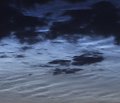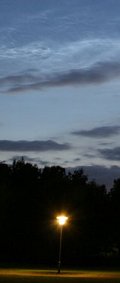| |
Observing
tips: Look
west 30 to 60 minutes after sunset when
the Sun has dipped 6o to 16o below the horizon.
If you see luminous blue-white tendrils spreading across the sky,
you've probably spotted a noctilucent
cloud. Although
noctilucent clouds appear most often at arctic latitudes, they have
been sighted in recent years
as far south as Colorado, Utah and Virginia. NLCs are seasonal,
appearing most often in late spring and summer. In the northern
hemisphere, the best time to look would be between mid-May and the
end of August. See also 2003,
2004, 2005,
2006 and 2007. |
 |
| |
| |
Photographer,
Location |
Images |
Comments |
|

|
P-M
Hedén,
Vallentuna, Sweden
Jun. 26, 2008 |
#1,
#2, #3,
more |
At
last some NLC here in Sweden too!
Photo
details: Sigma 20mm & Canon 450D |
|


|
Stanislaw
Rokita,
Torun, Poland
Jun. 26, 2008 |
#1,
#2,
#3,
#4,
|
The
evening was cloudy so I didn't expect nothing special on
the sky, but when I looked about 11pm through my window
I was really surprised: the northern horizon was very bright,
but it wasn't "normal" light, that were NLC! I was shocked
- they were so bright and perfectly visible. It was amazing.
I didn't expect to see such view almost from the centre
of the city.
Photo
details: Fuji FinePix 6500fd, ISO 100-400, Ap.
3-3.9, ex. 3-8s. |
|

|
Aurimas
Dirse,
Vilnius, Lithuania.
Jun. 26, 2008 |
#1,
#2, #3,
#4 |
Noctilucent
clouds in Vilnius. It is a second night they are visible.
But this night they were very bright and very high in the
sky! |
|

|
Michal
Laszczynski,
Gdynia, Poland
Jun. 26, 2008 |
#1,
#2,
#3,
#4 |
Very
spectacular bright noctilucents show this night! Pictures
were taken between 1h52m and 2h11m after sun set. Lower
clouds finished this spectacle.
Photo
details: Canon A620, ISO 100, 1.3s to 6s for last
shot. |
|

|
Camilla
Bacher Kiming,
Greve, south of Copenhagen, Denmark.
Jun. 24, 2008 |
#1,
#2,
#3,
#4,
more |
I've
been watching NLS' for more than 20 years, and this was
one of the better displays. Very bright and with excellent
detail. An interesting observation is that NLC's seem to
be bright at first, then get weaker and with less detail,
even if it gets darker. Wonder if sunlight plays a role
in their formation? |
|

|
Cezary
Wierucki,
Kolbudy, Poland
Jun. 26, 2008 |
#1 |
The
NLC that is currently visible is the brightest one I've
ever seen so far.
Photo
details: Canon 400D, ISO100 4s exp via 17-40 f/4
lens set to 17mm |
more
images (June 26): from
Olga 40 km south of Warsaw, Poland; from
Darius Petrauskas of Kaunas, Lithuania;
|
|
|








